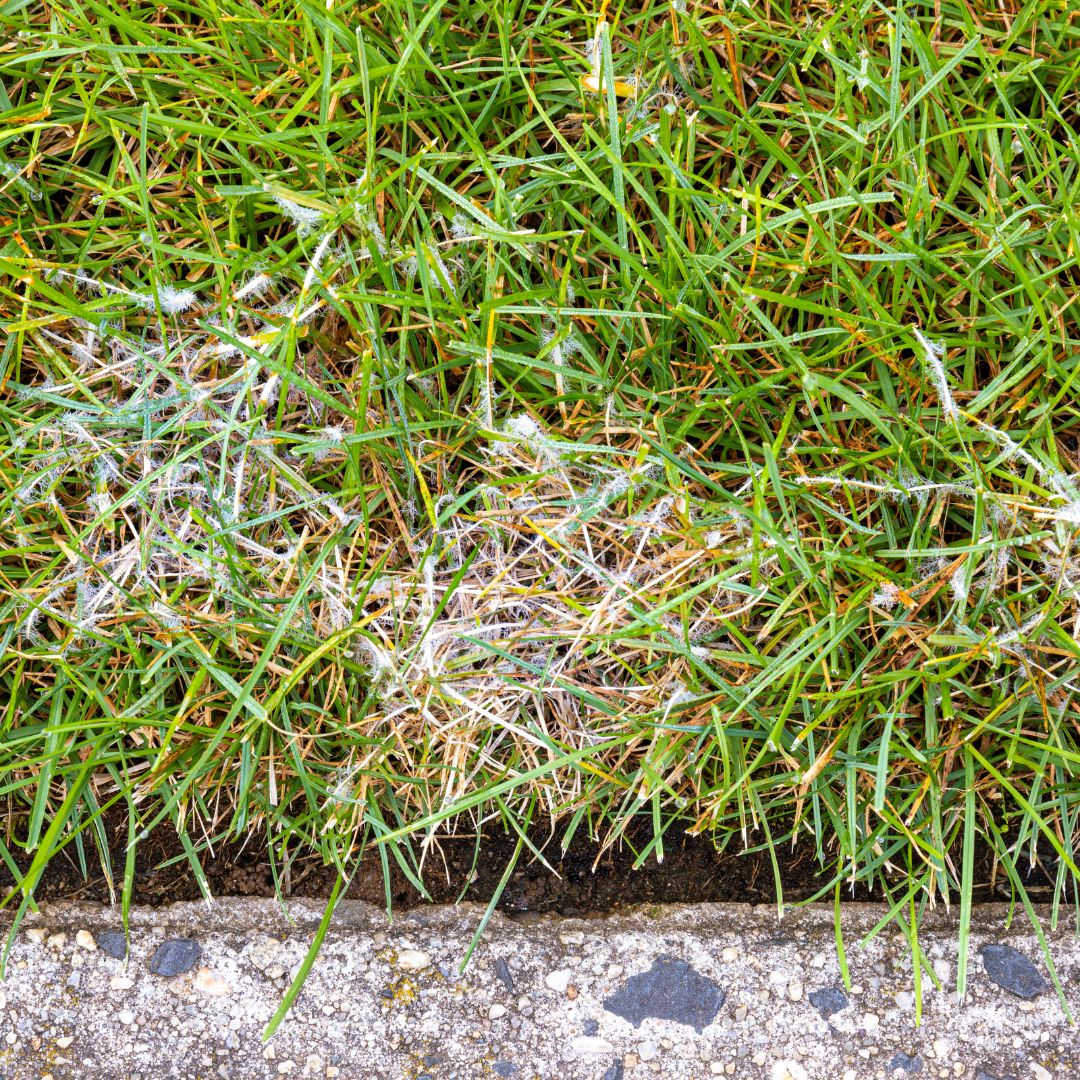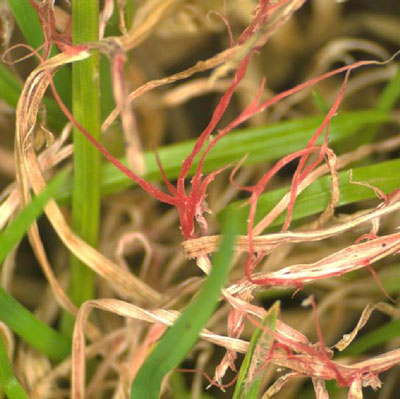
No matter how hard you work, there will inevitably come a time when your turf has issues. Now, there are several things you can do to help prevent them from occurring. Unfortunately, some things are out of your control.
When you notice something strange happening to your turf, there’s a good chance that fungus is to blame. Some fungal lawn diseases are more severe than others. Understanding the often subtle differences among the diseases is essential so you know the most appropriate way to care for the affected area.
This article will highlight some of the most common fungal lawn diseases, their appearance, and how to treat them. We’ll also touch on some tips to make your turf more resilient to these tiny lawn disruptors.
Spotting Lawn Diseases
Discolored spots on your turf could indicate that you’re experiencing issues. But many fungal lawn diseases start a little subtler. By looking closer at distressed areas, you may get a better idea of the issue and how to take care of it.
Here are some things to look for:
- Leaf spots: Discolored areas on the blades of grass
- Blight: General deterioration of the grass blades
- Dieback: When blades of grass appear to be dying from the tip.
- Root Rot: When the root system appears to be dying or dead.
Brown Patch
Brown patch is a fungal disease that affects lawns–especially tall fescues & perennial rye lawns. It is caused by Rhizoctonia solani fungus.
The lawn disease causes circular patches of dead grass to appear. The patches are typically brown or gray and can be found on upright blades. The size can be as small as a few inches to several feet in diameter.
Brown patch can start appearing in the late spring to early fall–whenever there is hot, humid weather. The ideal conditions for this disease to develop: the turf remains wet for a long time, and the temperatures are above 80℉ during the day and 65℉ at night.
Turf that yellows rapidly in a roughly circular shape is a good sign of brown patch.
Treating Brown Patch
Brown patch could be treated with a broad-spectrum control and prevention lawn fungicide. Bare spots can be reseeded once the disease is under control.
Dollar Spot

Dollar spot is caused by the fungus Clarireedia jacksonii or Sclerotinia hemeocarp. It affects both warm-season and cool-season grasses. If you have a golf course as an asset, there’s a good chance you’ve run up against this tiny turf disruptor.
Areas affected with dollar spot may have small “silver dollar” sized tan spots appear. Those spots can grow and spread.
One way to identify dollar spot is by looking at the grass blades. If you notice hourglass-shaped lesions with lighter centers and reddish-brown or purple borders, that’s a good indication you’re dealing with dollar spot.
Dollar spot shows up in late spring to early summer when temperatures are between 60 and 90℉. It can also appear when the weather is warmer in the early fall.
Treating Dollar Spot
Dollar spot is prone to fungicide resistance, so if you use fungicides to treat it, you should consider rotating products. And only use products when absolutely necessary.
You also want to ensure you’re actively doing the lawn care best practices mentioned at the end of this article.
Summer Patch
Summer patch is another fungal disease typically affecting Kentucky Bluegrass and fine fescues lawns. This fungal disease, caused by Magnaporthiopsis poae, affects the leaves and roots of the turf, making it much worse than some of the other fungal lawn diseases.
Initially, you may see 1 to 2-inch circular patches of dead grass. The patches can grow to form rings or crescent-shaped patches as big as 12 inches in diameter. The shapes could also eventually connect. Roots infected by summer patch are dark brown or black. They also appear rotting and shorter than healthy turf roots.
Summer patch can appear in the late spring and–you guessed it–summer when the turf root growth has slowed. Ideal conditions are when the temperatures average 90℉ or hotter.
Treating Summer Patch
Like brown patch, fungicides can help reduce the severity of a summer patch outbreak. Penetrant fungicides are formulated to reach roots affected by summer patch. It may be helpful to aerate the area before spraying to get the roots. Also, consider irrigating before and after the application.
There’s a good chance you need to reseed some areas after the disease is under control.
Grass Rust
Grass rust is caused by several species of fungus called Puccinia or Uromyces. It usually affects Bermuda grass, Kentucky bluegrass, tall fescue, and perennial ryegrass. If you’re noticing your workboots covered in a substance that looks like orange or brown dust, there’s a good chance your turf is afflicted with this disease.
It’s pretty easy to determine if your turf has grass rust. Aside from dirty boots, you will notice small yellow dots on the grass blades. Those dots form into orange or brown pimple-like sacs that spread a powdery substance when ruptured.
Grass rust develops in the summer or early fall. Heavy rain, cool nights, and cloudy, humid weather followed by hot sunny weather are the ideal conditions for this fungal disease to flourish.
Treating Grass Rust
You may be able to skip the fungicides if you adjust your lawn maintenance for an area. When possible, try to reduce the moisture levels of your turf. When you must water, do it in the morning.
Also, use a high-nitrogen fertilizer with a slow-release formula. If possible, bag grass clippings instead of letting them scatter and spread the rust.
Red Thread

Red thread is another “colorful” lawn disease caused by the fungus Laetisaria fuciformis. It affects the leaves of grass and can give the appearance of reddish-pink blades mixing with the other turf.
Red thread starts by looking like pink or tan circular patches. They could be anywhere between 1 inch to 2 feet in diameter. The telltale sign of red thread is the pinkish-red, antler-like threads coming from the tips of the infected grass leaves.
Red thread can develop when air temperatures are between 40 and 75℉. The best conditions are between 60 and 75℉ with high humidity and excessive moisture. It is usually most severe in the spring and fall.
Treating Red Thread
The best way to treat red thread is to tighten the lawn care routine to help speed up turf growth. Remove excess thatch and make sure the area has the proper fertilization. If irrigating, make sure the site does not get overwatered.
Fungicides are available to help control red thread, but if you change the turf care routine, they may not be necessary.
Turf Care Best Practices
Chemical treatments seem like the easy solution to lawn disease. But, as we all know, they can be costly, especially when treating a large area. Plus, there are other environmental impacts of overusing herbicides and fungicides.
Ensuring your assets have strong, healthy, and resilient lawns help to prevent these diseases from occurring or getting out of hand.
You’re likely doing some–or all–of these things at your parks and assets, but it’s always worth repeating. Here are some best practices to help keep lawns strong and resilient to common diseases.
- Aerate in the fall or spring. Aeration helps promote deeper, healthier root systems.
- Schedule Regular inspections. Catch a lawn disease early, and it will cause less damage to your turf.
- Use fertilizer with nitrogen: Nitrogen-rich fertilizers promote rapid turf growth with a deeper green color.
- Irrigate thoroughly–but not too much. Allow time for turf to dry out between deep waterings.
- Redirect traffic on stressed grass. Give overused lawns periodic breaks over the summer. Reschedule activities or section off an area that looks stressed or damaged.
- Use disease-resistant grass seed varieties. If you’re unsure of the desirable turfgrass for your area, you can consult the National Turfgrass Evaluation Program’s website.
- Limit traffic in the affected area. Disease fungi are spread from one area to another by water, wind, shoes, mowers, and other equipment.
- Maintain your mowers. Mowers with sharp blades that run well cause less stress on the turf.
The Takeaway
Not all fungi lurking near your turf are bad. In fact, soil fungi make up 10 to 30% of the soil rhizosphere–and that’s just a fraction of the microorganisms existing under the turf.
Using lawn care best practices can prevent lawn fungal disease from taking over your turf. If you notice discoloration on your lawn, investigate the area to determine the cause. If it is a fungal lawn disease, address the issue promptly and see where to revise your care plan for that area.
